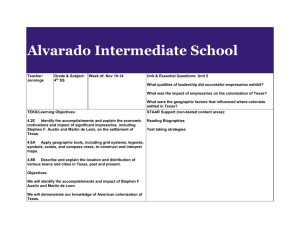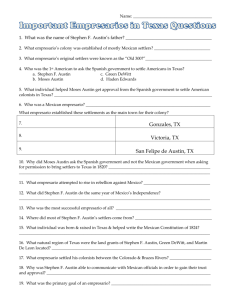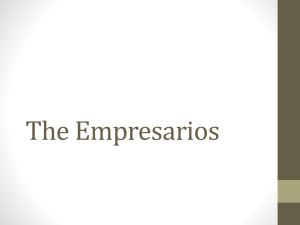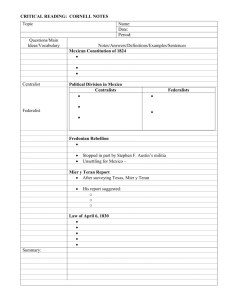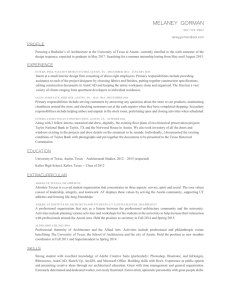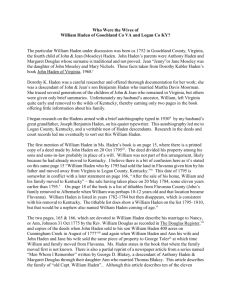Empresario`s Desktop Lesson
advertisement
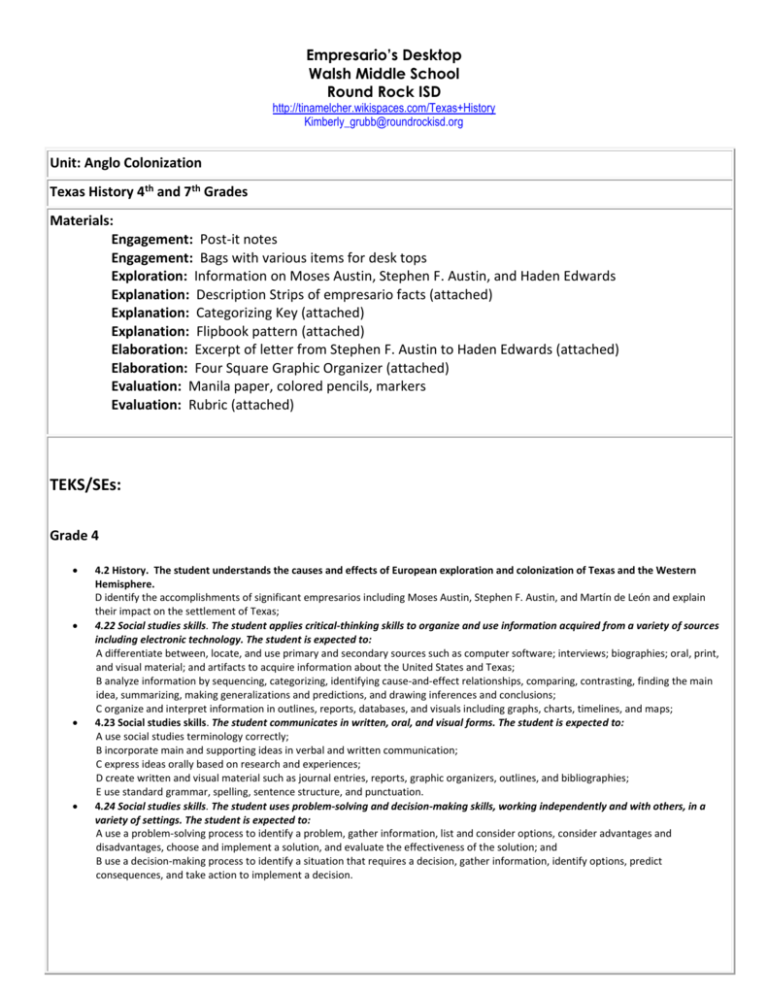
Empresario’s Desktop Walsh Middle School Round Rock ISD http://tinamelcher.wikispaces.com/Texas+History Kimberly_grubb@roundrockisd.org Unit: Anglo Colonization Texas History 4th and 7th Grades Materials: Engagement: Post-it notes Engagement: Bags with various items for desk tops Exploration: Information on Moses Austin, Stephen F. Austin, and Haden Edwards Explanation: Description Strips of empresario facts (attached) Explanation: Categorizing Key (attached) Explanation: Flipbook pattern (attached) Elaboration: Excerpt of letter from Stephen F. Austin to Haden Edwards (attached) Elaboration: Four Square Graphic Organizer (attached) Evaluation: Manila paper, colored pencils, markers Evaluation: Rubric (attached) TEKS/SEs: Grade 4 4.2 History. The student understands the causes and effects of European exploration and colonization of Texas and the Western Hemisphere. D identify the accomplishments of significant empresarios including Moses Austin, Stephen F. Austin, and Martín de León and explain their impact on the settlement of Texas; 4.22 Social studies skills. The student applies critical-thinking skills to organize and use information acquired from a variety of sources including electronic technology. The student is expected to: A differentiate between, locate, and use primary and secondary sources such as computer software; interviews; biographies; oral, print, and visual material; and artifacts to acquire information about the United States and Texas; B analyze information by sequencing, categorizing, identifying cause-and-effect relationships, comparing, contrasting, finding the main idea, summarizing, making generalizations and predictions, and drawing inferences and conclusions; C organize and interpret information in outlines, reports, databases, and visuals including graphs, charts, timelines, and maps; 4.23 Social studies skills. The student communicates in written, oral, and visual forms. The student is expected to: A use social studies terminology correctly; B incorporate main and supporting ideas in verbal and written communication; C express ideas orally based on research and experiences; D create written and visual material such as journal entries, reports, graphic organizers, outlines, and bibliographies; E use standard grammar, spelling, sentence structure, and punctuation. 4.24 Social studies skills. The student uses problem-solving and decision-making skills, working independently and with others, in a variety of settings. The student is expected to: A use a problem-solving process to identify a problem, gather information, list and consider options, consider advantages and disadvantages, choose and implement a solution, and evaluate the effectiveness of the solution; and B use a decision-making process to identify a situation that requires a decision, gather information, identify options, predict consequences, and take action to implement a decision. Grade 7 7.1 History. The student understands the traditional historical points of reference in Texas History. C explain the significance of the following dates: 1519, 1718, 1821, 1836, 1845, and1861 7.2 History. The student understands how individuals, events, and issues prior to the Texas Revolution shaped the history of Texas. C identify the contributions of significant individuals including Moses Austin, Stephen F. Austin, and Juan Seguín during the colonization of Texas; 7.18 Citizenship. The student understands the importance of effective leadership in a democratic society. The student is expected to: A identify the leadership qualities of elected and appointed leaders to Texas, past and present, including Texans who have been President of the United States. 7.21 Social studies skills. The student applies critical-thinking skills to organize and use information acquired from a variety of sources including electronic technology. The student will: A differentiate between, locate, and use primary and secondary sources such as computer software, databases, media and news services, biographies, interviews, and artifacts to acquire information about Texas B analyze information by sequencing, categorizing, identifying cause-and-effect relationships, comparing, contrasting, finding the main idea, summarizing, making generalizations and predictions, and drawing inferences and conclusions C organize and interpret information from outlines, reports, databases, and visuals: graphs, charts, timelines, and maps 7.22 Social studies skills. The student communicates in written, oral, and visual forms. The student will: A use social studies terminology correctly; B use standard grammar, spelling, sentence structure, and punctuation; C transfer information from one medium to another, including written to visual and statistical to written or visual, using computer software as appropriate; and D create written, oral, and visual presentations of social studies information. 7.23 Social studies skills. The student uses problem-solving and decision-making skills, working independently and with others, in a variety of settings. The student will: A use a problem-solving process to identify a problem, gather information, list and consider options, consider advantages and disadvantages, choose and implement a solution, and evaluate the effectiveness of the solution B use a decision-making process to identify a situation that requires a decision, gather information, identify options, predict consequences, and take action to implement a decision. LESSON OBJECTIVE: Students will analyze the qualities and accomplishments of empresarios in Texas History, focusing on the leadership qualities of each. ENGAGEMENT- Students will describe tools that people use to do their jobs, and how the things around a person identifies his/her characteristics Materials: Post-it notes, Bags with various items for desktops What’s in Your Room? – Students will list 5 things on a post-it that someone would find in his/her room. The things they list must tell something about them. Students will share the items with their table groups, and the significance of those items (students could also put the post-its on the board and the class could try to guess who the list describes). World Café- The teacher will place a paper bag with items on each table. The students will go around and write on butcher paper what they can tell about the person from the items in each bag. Each group must write something different, so the task gets harder as it progresses. 2 Examples/Ideas for the bags: Cook: cookbook, spatula, apron, measuring cups, cookie cutters Explorer: maps, compass, Scientist: beakers, goggles Teacher: ruler, textbook, red pen -ORHave samples of items from various teachers/counselors/administrators and ask students to predict to whom the items belong. Option: pictures of desks (i.e. principal, superintendent, president) EXPLORATION- Students will research one empresario, and share information with two other students Materials: Information on Moses Austin, Stephen F. Austin, and Haden Edwards Empresario Jigsaw- Divide students into groups of three. One student from each group will research one of the following: Moses Austin, Stephen F. Austin, Haden Edwards. Students can use their textbooks, handouts, or the Handbook of Texas Online website (http://www.tshaonline.org/handbook/online/index.html). Students become “experts” on the empresario they study. Hand Profile- Students will trace around their hands as a template to record information: Thumb: Write “Who” the empresario is (personal information); Index Finger: Write “What” the empresario did; Middle Finger: Write “When” the empresario settled; Ring Finger: Write “Where” the empresario settled; Pinky Finger: Write “Why” they came to Texas. In the Palm of the hand, write the significance of that individual. Triad Share- Once students have completed their Hand profile, they will share the information with the other two students in their triad. Differentiation Students research only two of the empresarios Students work in pairs to research Research Martin de Leon and create a chart listing information about him 3 EXPLANATION- Students will categorize the information they have gathered about the empresarios Materials: Description Strips (attached), Key to Categorizing (attached), Flipbook Pattern (attached) Categorizing- Still in their triads, students will go through the Description Strips that describe the three empresarios and categorize them under the proper heading: Moses Austin, Stephen F. Austin, and Haden Edwards Flipbook- Students use the flipbook handout to check their categories. They then fold the flip book and put a title on the front that tells which empresario is described under that flap. Students then add at least three pictures that represent the important facts to remember about the empresario. Differentiation Students create a Venn diagram together using the information they learned. Students create strips of their own and trade with another group to categorize. Students create a flipbook of the empresarios using the facts they found. ELABORATION- Students will analyze an excerpt of a letter from Stephen F. Austin to Haden Edwards Materials: Excerpt of letter from Stephen F. Austin to Haden Edwards (attached), Four Square Graphic Organizer (attached) Students read the letter from Stephen F. Austin to Haden Edwards and complete the graphic organizer Differentiation: Students read and create a timeline of the relationship of Stephen F. and Haden Edwards using the following website (http://www.tamu.edu/ccbn/dewitt/fredonian.htm) EVALUATION- Students will show a depth of knowledge about Stephen F. Austin by selecting what might have been on his desk Students will create a “Desk Top” for Stephen F. Austin that includes the following elements: - Name Plate/business card (some way to identify the desk as belonging to Stephen F. Austin) Calendar with at least one important date marked Journal Entry An award he may have received Picture of someone/something important to him To Do List: 5 important things to do in his life. These may or may not be checked off, but they must be things he actually did A meaningful object or memento A book he could have written Teacher will use the rubric (attached) to score the products Differentiation Students research a government official of today, and create a desktop for him/her. Students create desktops for opposing political candidates (i.e. Governor’s race) to show how they are different Students list leadership qualities of the empresarios, and create a poster that illustrates those qualities 4



